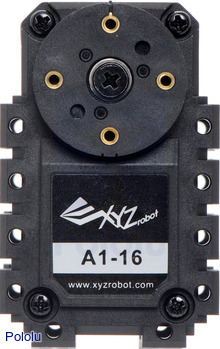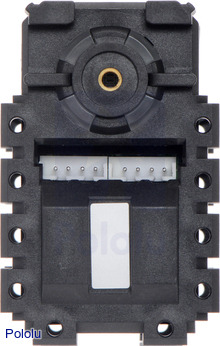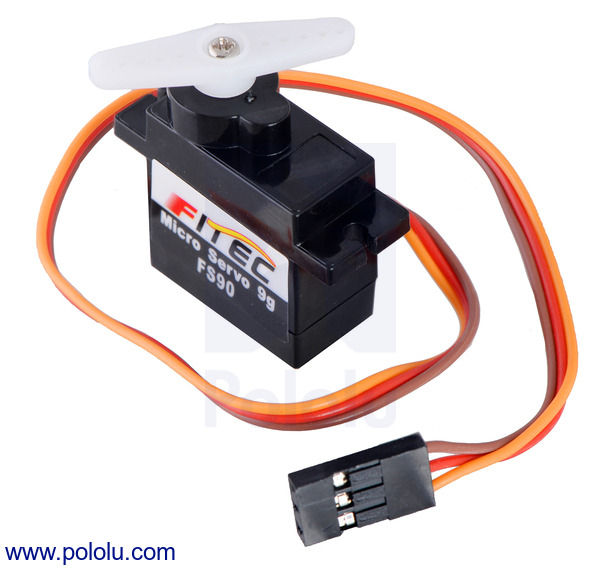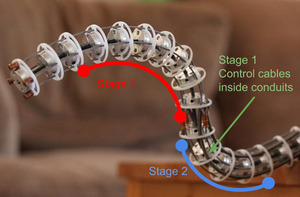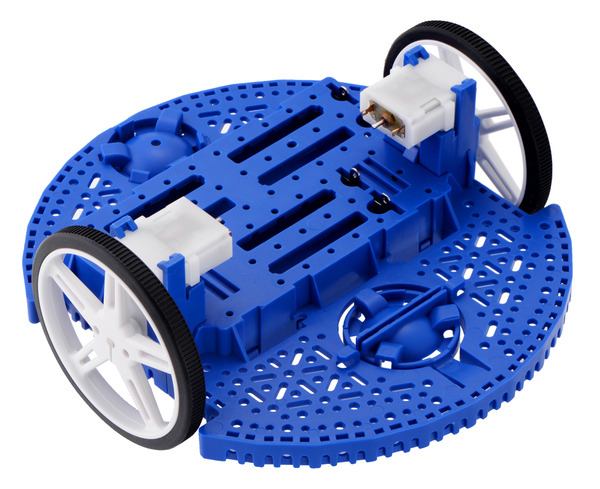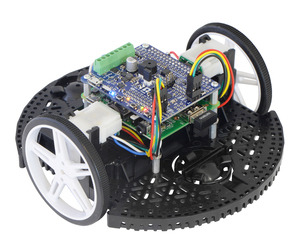Pololu Blog »
Pololu Blog (Page 34)
Welcome to the Pololu Blog, where we provide updates about what we and our customers are doing and thinking about. This blog used to be Pololu president Jan Malášek’s Engage Your Brain blog; you can view just those posts here.
Popular tags: community projects new products raspberry pi arduino more…
RC wildlife photography usingTReX motor controllers and RC switches
Wildlife photographer Stéphane Simoëns uses a remote-controlled, camouflaged vehicle to bring his camera closer to animals without scaring them away. The vehicle is a custom-built, metal-framed, 4-wheeled chassis that is controlled with a pair of our TReX dual motor controllers. One TReX drives while the other provides tilt control for the onboard camera. The vehicle also features three of our RC switches; one switches on and off the video transmitter and the other two control camera shutter and focus. You can find more information about this project in Stéphane’s forum post.
|
|
New products: XYZrobot Bolide humanoid robot DIY kit and A1-16 smart servo
|
|
We are now offering two new products from XYZrobot: the Bolide Y-01 advanced humanoid robot DIY kit and the A1-16 smart servo.
The Bolide Y-01 DIY kit from XYZrobot comes with all of the components needed to build this advanced humanoid robot, including a Bluetooth controller, an Arduino-compatible ATmega1280 microcontroller, sensors, and 18 A1-16 smart servos. The ATmega1280 microcontroller comes preprogrammed to perform a range of complex movements, including dancing, walking and standing up in response to commands from the included Bluetooth remote or a smartphone or tablet running the XYZrobot app. The control board includes a three-axis accelerometer for maintaining postural stability and detecting falls, and the robot also has a distance sensor in its chest that can detect objects in front of it. For those interested in expanding the capabilities of this robot beyond the preprogrammed routines, the Bolide Y-01 control board can be programmed with the Arduino IDE and the XYZrobot Editor software. You can find more details about the Bolide Y-01 advanced humanoid robot DIY kit on its product page.
|
|
We are perhaps even more excited about carrying the A1-16 smart servos separately. These specialty servos are well suited for applications such as humanoid robots, hexapod robots, and robotic arms that require strong and complex actuation. Unlike the usual RC hobby servos, these servos are not only capable of 360° continuous rotation, but they also offer position control over an effective 330° range. To achieve this kind of motion, they use a TTL serial interface, which also allows them to be daisy chained and controlled from the same serial bus (this is their only method of control, so they will not work with standard RC receivers and servo controllers). In addition, these smart servos provide additional feedback such as position, speed, and temperature! The four-color LED featured on each servo is used as a visual error indicator by default, which is really handy to quickly determine if servos in a chain are experiencing a problem. Alternatively, this LED can be manually controlled through the serial interface. See the A1-16 smart servo product page for more information about this feature-packed servo.
New product: FEETECH FS90 Micro Servo
We are now carrying the FEETECH FS90 micro servo. At a weight of only 9 g and less than inch long, this servo is great for actuating tiny mechanisms. We also carry the continuous-rotation version of this servo, the FEETECH FS90R.
Animatronic tentacle mechanism using Pololu Universal Mounting Hubs
|
|
While our Universal Mounting Hubs are mainly intended as general-purpose adapters for motor shafts, it seems that they can also be used to help build a cable-actuated animatronic tentacle. Joshua Vasquez posted an article on Hackaday about his two-stage tentacle mechanism with “vertebrae” made from Universal Mounting Hubs and laser-cut Delrin pieces. (We didn’t do the laser cutting for this project, but our custom laser cutting service might be interesting for anyone wanting to make similar parts.) If you want to simultaneously impress and creep out your friends this Halloween, this seems like an interesting project to try!
Read more about Joshua’s project on Hackaday.
Video: Romi chassis assembly
Control a GoPro remotely using a CamDo Bullet and RC switch
When capturing photographs of wildlife, it is not always feasible to be close enough to trigger your camera with a standard wired remote. In these cases, using an RC transmitter and receiver pair would be ideal, but most cameras and their remotes do not accept hobby RC signals. This blog post, written by CamDo, explains how to use one of our RC switches with a built-in relay and their Bullet wired remote interface to trigger a GoPro camera from an RC transmitter from hundreds of meters away. The setup can be used with any standard RC transmitter and receiver pair, and you only need one pair and one RC switch to control several cameras at once.
New Romi chassis
I am excited to announce the release of the Romi chassis, our new platform for mobile robotics. Romi is a 6.5″-diameter round chassis that includes all the basic mechanical parts that you need for a mobile robot: a base plate with integrated battery holder, motors and motor brackets, wheels with silicone tires, and a ball caster as a third point of contact.
 |
The Romi chassis is designed to be extended. It includes numerous mounting holes and slots, including specific spots for Arduino and Raspberry Pi and a place in front for a second ball caster. The motors have extended shafts for use with Romi encoders in applications requiring precision. For power, you can choose between four and six AA cells; we recommend the Romi power distribution board for access to battery power.
As an example of what you can do, here is the chassis with a Raspberry Pi A+ and our A-Star Robot Controller mounted on top, with power, motors, and encoders all fully connected and operational:
|
|
The chassis is available in six different colors, and if you want to mix and match, you can head over to our Romi Chassis Components category and select the parts you want.
Video: Smart lane changing Zumo robot
Forum member WaterBoy23 recently shared his robot which expanded upon the line following capabilities of our Zumo Robot for Arduino by adding in lane changing capabilities. The robot changes lanes when it detects a vehicle ahead of it, and is programmed to either pass the vehicle or return quickly to its original lane if it detects oncoming traffic. His robot uses two Arduino Uno boards, one for following the line and the other for reading ultrasonic position sensors. More information about the robot can be found in WaterBoy23’s post on our forum.
Pololu Labor Day weekend sale
We are having a big Labor Day sale throughout the weekend, with 15% discounts on over 800 products when you use the coupon code LABORDAY16. Note that we will be closed on Monday, so orders placed after 2 PM Pacific Time on Friday, September 2 will be shipped on Tuesday, September 6.
For more information, including all of the sale items, see the sale page.
New product: T1-3/4 (5mm) RGB LED with Diffused Lens (5-pack)
We are now selling T1-3/4 (5mm) common anode RGB LEDs! These multi-color LEDs contain red, green, and blue (RGB) elements that can be mixed to produce different colors. The three color elements share a common anode and are encased in a diffused white lens that blends the colors and widens the viewing angle. This product is a pack of five (5) RGB LEDs.
 |
These LEDs replace the RGB LEDs with a common cathode that we used to sell. The common-anode setup of the new ones is nice because you can drive the LEDs with a low-voltage microcontroller I/O pin in an open-drain configuration (provided the pins can handle the current and are tolerant of the LED supply voltage). If you need to build your own drive circuit, you just need one low-side transistor per LED.
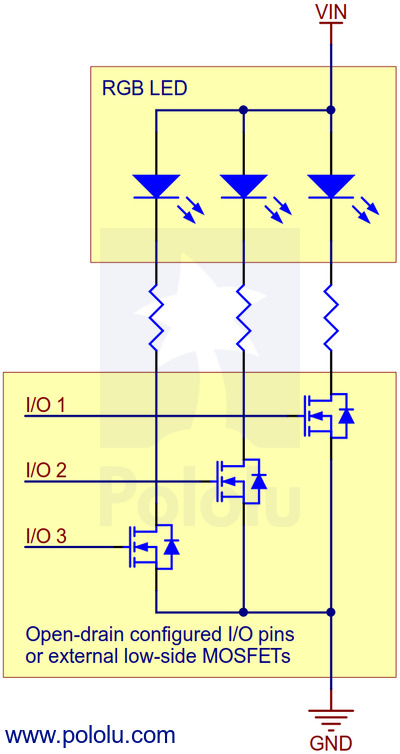 |
Here are some other posts on our blog about LEDs:







